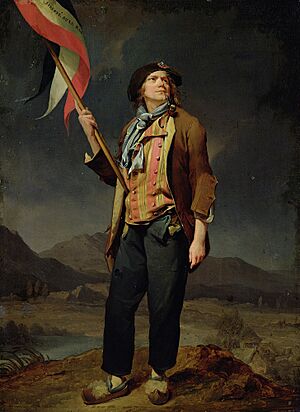Sans-culottes facts for kids
The sans-culottes were a group of ordinary people in France during the late 1700s. Their name means "without breeches" because they wore long trousers instead of the fancy short pants (called culottes) that rich people wore. These everyday people became strong supporters and fighters for the French Revolution. They wanted big changes because they lived difficult lives under the old system of government, known as the Ancien Régime. The word "sans-culotte" was first used in 1791. It became popular during protests in June 1792.
Who Were the Sans-Culottes?
The name "sans-culotte" might sound like it's just about clothes. But it actually showed their social status. Culottes were fashionable silk knee-breeches worn by the nobles and wealthy people. The working-class sans-culottes wore pantaloons, or long trousers, instead.
Most sans-culottes were city workers. They were the main driving force behind the French Revolution. Other revolutionaries saw them as "radicals." This was because the sans-culottes wanted a direct democracy. This meant that people would vote directly on laws, without needing a separate group of lawmakers.
Even though they often had simple clothes and equipment, and didn't get much help from the rich, they made up most of the French Revolutionary Army. They played a big part in the early years of the French Revolutionary Wars.
Images for kids
-
François Hanriot chef de la section des Sans-Culottes (Rue Mouffetard); drawing by Gabriel in the Carnavalet Museum
See also
 In Spanish: Sans-culottes para niños
In Spanish: Sans-culottes para niños





